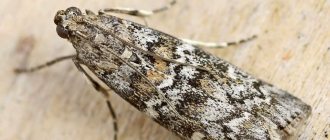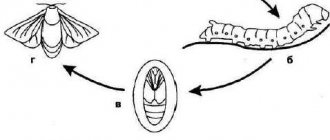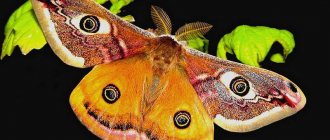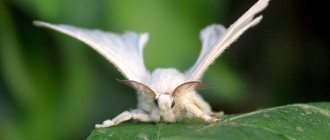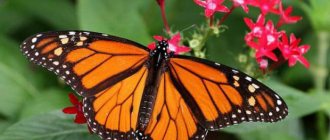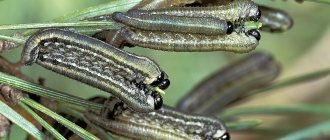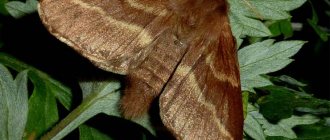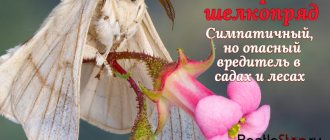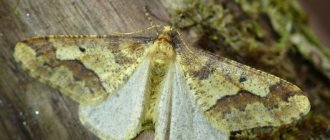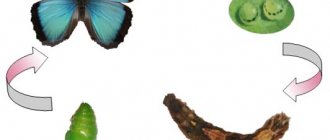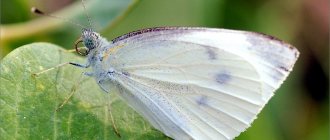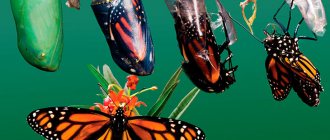The silkworm is a species of butterfly that became the basis for the development of sericulture, the production of natural fabrics based on threads that in nature are woven by caterpillars that feed on the leaves of the mulberry tree (mulberry). According to classification criteria, it belongs to the kingdom of Animals, phylum Arthropods, class Insects, order Lepidoptera, family True silkworms, genus Bombix, according to the Latin nomenclature Bombix mori (L.). The species was described by Carl Linnaeus in 1758.
The natural distribution area is eastern Asia, northern China, Primorye. It was domesticated by humans, according to various sources, from one thousand to five thousand years ago. Currently not found in the wild.
Dietary features and lifestyle
In the life cycle of the silkworm, four stages of development are clearly distinguished:
- egg (grena);
- caterpillar (larva);
- pupa in a cocoon;
- butterfly (adult, imago).
Silk producers from different countries choose breeds and hybrid forms of silkworms that differ from each other in physiological and economically valuable characteristics, and are most adapted to local climatic and organizational and economic conditions. The fundamental difference between the breeds is the annual number of generations of workers:
- one - monovoltine;
- two – bivoltine;
- several are multivoltine.
Let us consider in more detail the characteristics of each period in the life cycle of an insect.
Silkworm eggs are very small; one gram contains 1500-2000 eggs. One female lays 500-700 eggs. Greens are oval in shape, slightly flattened on the sides, and have an elastic translucent shell - a white or light yellow shell. After laying, the eggs begin their development during the first two days, which is externally manifested in a change in the color of the shell from light to pink and purple, and its hardening.
The optimal temperature for incubation (winter storage) is 2-4o C. Such conditions allow the larvae to hatch simultaneously with the opening of the mulberry leaves.
Caterpillar
Silkworm larvae are called silkworms, but according to their biological characteristics they are caterpillars. In appearance, their body is elongated, the head, chest and abdomen, ending in a horny appendage, are clearly distinguishable. There are 8 pairs of legs: 3 pairs of thoracic and 5 abdominal. The outside of the body is covered with a chitinous cover without pubescence - this is the exoskeleton, muscles are attached to it.
In the development of caterpillars, five instars are distinguished, one more than the number of molts. The lifespan of the organism is 20-38 days. During this short period, the size of the body increases by 30 times, and the mass by tens of thousands of times. During the molting period, the caterpillar looks for an attachment site. To do this, she uses her abdominal legs, and the front part of her body rises.
After molting, the return to increased nutrition occurs slowly. It will take some time until the new cover becomes harder and more durable. Along with this, the legs become larger and acquire hooks.
The color of caterpillars varies depending on age:
- in the first instar dark brown or black;
- in the second, a light color appears on the chest;
- in the third and fourth - carpet coloring;
- in the fifth it is white or light green.
The structure of the silk gland consists of the following sections:
- fibrin secretion department;
- a tank for storing it;
- excretory ducts (paired and unpaired).
In the unpaired duct they find the so-called “drawing machine” - a device found in the insect, the structure of which determines the thickness of the silk thread.
At the end of the fifth instar, which lasts 8-12 days, the caterpillars are completely covered with a cocoon, molting occurs inside, after which the caterpillar inside the cocoon turns into a pupa.
Doll
The process of turning a caterpillar into a pupa - pupation - takes 4-5 days. The pupal stage is a complex continuous process of quantitative and qualitative changes in the insect’s body, lasting 12-18 days, as a result of which a butterfly emerges from the cocoon.
About a day before the butterfly emerges, there is noticeable movement and slight noise in the cocoon. The future butterfly first sheds the outer covers of the pupa, then secretes a liquid that dissolves the adhesive substance sericin, which glued the threads of the cocoon. The butterfly emerges strictly from 5 to 6 am.
Diagnostic signs
| Siberian silkworm eggs | Siberian silkworm caterpillar |
Butterflies
especially during periods of mass reproduction, they are so diverse in color and size that it is difficult to pick a pair of butterflies that are completely similar to each other. Females have short combed antennae and a thick body; their wingspan is from 6 to 10 cm. Males have clearly combed antennae and a more slender body; their wingspan is from 4 to 7.5 cm. The forewings of both sexes are light brown or light gray to almost black. Three jagged stripes run across them; one along the outer edge of the snout, the second near its middle and the third closer to its base. In close proximity to the dark stripes, often along the outer edge of the wing, there are whitish stripes consisting of semilunar spots and strokes. The field between the main and median stripes is often darker in color. Sometimes the main and median stripes are weakly expressed or even completely absent. Near the middle of the main stripe there is a semi-lunar white spot, which is always present in butterflies. The hind wings are light brown without a pattern. Below, both pairs of wings are brown, and there is one wide dark brown curved band running along them. The head and chest are colored similar to the front wings, the abdomen is similar to the hind wings.
Testicles
spherical, 2.0×1.5 mm in size, with a dark dot at the apex. Freshly laid eggs are bluish-green, then turn grey. They are smaller and somewhat lighter than those of the pine silkworm, they are deposited in irregular groups from several to 100 pieces and mainly on needles, twigs, twigs, the bark of branches and trunks. When the caterpillar emerges from the egg, it eats part of the shell.
Caterpillars
up to 11 cm long, varied in color - from gray to almost black. On the meso- and metanotum there are transverse bands of steel-blue burning hairs that open wide when the caterpillar raises the front part of the body and bends its head (threat pose). On the next seven abdominal tergites there are dark horseshoe-shaped spots. The dorsal side and spots on the sides are covered with silvery-white spear-shaped scales, developed to varying degrees in individuals. On the sides of the body, areas of skin are ocher-yellow, sometimes forming an almost continuous stripe. The body is covered with hairs, the longest and densest on its sides and in front on the prothorax. The head is round, matte, dark brown. Ventral side between legs with yellowish-brown or orange spots, not forming a continuous stripe.
The stool of the caterpillars is cylindrical, with six longitudinal and two transverse grooves, very similar to the stool of the pine silkworm. The pieces of needles in it are hardly noticeable.
Doll
up to 5 cm long, pitch-brown to black. Cremaster in the form of a transverse convex plate, densely covered with very small rufous hooked and simple setae. The last segments have short and sparse hairs. The pupa rests in a parchment-like, brownish or dirty-gray cocoon, into which tufts of blue, burning caterpillar hairs are woven, giving the cocoon its burning properties. Cocoons are located on branches, between needles, on trunks.
At the beginning of mass reproduction, dark-colored individuals of butterflies and caterpillars dominate, as in other mass pine needles and leaf-eating insects.
Types of silkworm
Nun silkworm
living in the forest. The wings are black and white, the antennae have long serrations. Reproduction occurs once a year, in summer. The caterpillars greatly damage coniferous trees, beech, oak and birch.
Nun silkworm butterfly
Ringed - has this name because of the characteristic shape of the clutch - in the form of an egg. The clutch itself contains up to three hundred eggs. It is the main enemy of apple trees. The body of the butterfly is covered with light brown fluff. Ringed silkworm
– it is its cocoons that are the main raw material for silk production.
Ringed silkworm butterfly
Pine silkworm
- a pest of pine trees. The color of the wings is brownish, close to the color of pine bark. Quite large butterflies - females reach a wingspan of up to 9 centimeters, males are smaller.
Pine moth butterfly
Gypsy moth
– the most dangerous pest, as it can affect up to 300 plant species. The name comes from the large difference between the female and the male in appearance.
Gypsy moth butterfly
Silkworm - interesting facts
- The silkworm received the name “mulberry” because its caterpillars eat mulberry leaves.
- The life cycle of a silkworm: the butterfly lays eggs, the larva develops, the caterpillar, after 12 days in the cocoon the insect turns into a butterfly.
- Man has domesticated this insect, it is completely dependent on us: the caterpillar does not get its own food, the butterfly has lost the ability to fly (there is no need) and feed on its own.
- Silk thread is obtained from the cocoon of the silkworm - it is simply twisted, and the cocoon itself is used for cosmetic purposes (creams and lotions).
- One insect cocoon produces up to 1000 meters of silk thread.
- In Central and South Asia there are factories for raising silkworms and making silk thread.
- The cocoons of these caterpillars are used not only for the production of fabrics, but also in cosmetology as a means of cleansing the skin. And in Asian cuisine, the caterpillars themselves are considered a delicacy and are eaten.
- 32 layers of silk are capable of holding a pistol bullet. Therefore, silk thread is used in the production of body armor.
- The nature of a silk thread is similar to a spider's web. Silk thread is a mixture of proteins and saliva of the mulberry caterpillar, from which they make their cocoons. The thread, like the web, is very strong. For example, a silk cable will be stronger than a metal cable of the same thickness.
- At one time, in Tsarist Russia, soldiers were given silk underwear in the army, in which parasites could not live.
- In ancient times, silk was worth its weight in gold.
- Silk thread is very durable and can withstand great pressure. Silk ropes are more efficient in operation than hummocks made of steel of the same thickness.
Few people know that the gypsy moth, which is a major pest of the US forestry industry, was spread as a result of a failed experiment. As they say, I wanted the best, but what happened was the following.
At the end of the nineteenth century, one person came up with the idea to breed a new species; he planned to cross the silkworm and the gypsy moth. To get an insect that is less “picky in food”, but at the same time it must produce silk thread. For this purpose, a batch of gypsy moth cocoons was brought from Europe to America. The experiment ended in complete failure. The scientist was unable to cross these types of silkworms, but the gypsy moth has “comfortably” settled down in America and is now causing harm to the forestry of the United States of America.
Video
https://youtube.com/watch?v=hW6bOFQrr7w
Sources
- https://givotniymir.ru/tutovyj-shelkopryad-nasekomoe-obraz-zhizni-i-sreda-obitaniya-tutovogo-shelkopryada/https://fb.ru/article/137966/tutovyiy-shelkopryad-kokonyi-tutovogo-shelkopryadahttps: //domikru.net/kak-delayut-shelk-tutovyj-shelkopryad-foto.htmlhttps://thewildlife.ru/bespozvonochnye/tutovyy-shelkopryad/https://kurspresent.ru/page/nasekomye-mnogonozhki-i-paukihttps: //apest.ru/nasekomye/babochki/vidy-babochek-i-gusenits/tutovyj-shelkopryad/https://vivareit.ru/tutovyj-shelkopryad-interesnye-fakty-i-foto/
The benefits and harms of silkworms
Man was able to tame the silkworm for his own benefit. The fabric made from its silk threads is highly valued in the market. Other types of silkworms are considered pests. Thanks to the natural food chain in nature, the number of silkworms is controlled. They have natural enemies, so outbreaks of the pest are leveled out.
Thanks to the scientific research of biologists, the breeding of desirable breeds of insects, taking into account the genotype, has long begun. This made it possible to achieve a greater length of silk thread. But in general, it gave great progress for the formation and development of the sericulture industry.
Silk cocoon can become a natural remedy for peeling and massaging the skin. In Asian countries, consumers are offered yellow cocoons for this purpose. This color is called gold for marketing purposes.
Sericulture
Mulberry worms are most often used in sericulture
Silk production dates back to ancient times and occupied an important place in the economies of eastern countries. Today, the main silk producing countries are India and China.
Mulberry worms are also bred quite widely in European countries, Korea, India and Russia.
Mulberry worms with white cocoons are bred for production purposes. Most often, Japanese, Chinese and European species of silkworms are bred in production. With the development of silkworming, new mixed breeds of silkworms are constantly being developed.
In large industries, the eggs of mulberry worms are grown in special incubators, where they turn into larvae in a couple of days. The larvae are then placed in special feeders with mulberry leaves, where they feed and grow. After the larvae grow, they are transferred to special cells where they will form a cocoon. The larvae begin to produce silk thread when they find the necessary support for fixation. Rotating their heads to the sides, the larvae form a frame, and then crawl inside and complete the formation of the cocoon.
To obtain silk thread in production, they do not wait until the moth is born. After a couple of days, the pupated individuals are collected and treated with steam. When treated with steam, the larvae inside die and the threads are easier to unwind. After steam, the cocoons are immersed in boiling water, which makes the thread more pliable.
In eastern countries, home breeding of silkworms is still widespread. The larvae are manually transferred to trays covered with mulberry leaves, and straw branches or lattice trays are used to form a cocoon.
The photo shows the stage of collecting silkworm cocoons.
It takes about two thousand pupated caterpillars to produce one silk item, such as a dress. Silk products are very expensive, which is due to the labor-intensive process of obtaining silk threads. With the development of technology, synthetic threads are replacing silk. But reviews about the characteristics of natural silk do not require additional comments. Natural fabric has a special richness and charm, and products made from silk thread are still considered an indicator of status and good taste.
How is silk obtained?
The main purpose of silk production is to obtain the silk thread that the caterpillar produces to create a cocoon. 8–10 days after pupation, the cocoons are heated with hot air (about +90 °C).
The chrysalis inside is dying. The cocoons are sorted by color and size, then washed in hot and cold water to dissolve the glue that holds the threads together.
Next, the process of unwinding the cocoon begins. Since the wires are very thin, they are connected in groups of 3 to 10 pieces. The resulting fiber is wrapped in yarn, and then the raw material is sent to weaving factories where silk is produced.
By the way, dead pupae left after unwinding cocoons are considered a very valuable nutritious dish.
What do caterpillars eat?
The hatched caterpillar first devours the shell of the egg in which it developed, and then proceeds to its main diet.
Most caterpillars are herbivores (phytophages) and feed on green mass and fruits of plants. According to the food supply, caterpillars are divided into 4 types:
- polyphagous - indiscriminate caterpillars that eat any vegetation, for example, the caterpillars of most moths;
- oligophages prefer plants of a certain family or genus. For example, swallowtail caterpillars eat only umbrella plants;
- Monophages consume a single type of vegetation. Thus, silkworm caterpillars feed only on mulberry leaves;
- xylophages do not eat anything except wood, and constitute a small variety of caterpillars - mainly glass beetles and wood borers.
The transitional form is considered to be a variety of caterpillars that eat lichens and tinder fungi. This category includes representatives of the genus of true moths. For example, the granary moth caterpillar thrives on poisonous ergot.
A few species of caterpillars are keratophagous by nature and eat elements of animal origin: horny substance, hair, wool and skin. Prominent examples are the caterpillars of furniture, carpet and clothes moths. Caterpillars of true moths eat only wax, and bee moths eat honey.
Predatory caterpillars are the smallest group: most cases of predation occur when the population density is high and there is a lack of usual food. For example, cotton bollworm and bear moth caterpillars are carnivorous and attack their own kind, weakened and diseased caterpillars.
Caterpillars of the narrow-snouted and raspberry moths, as well as the sun moth, which feed on scale insects, are considered natural predators. Predatory blueberry caterpillars eat aphids, and moth caterpillars are exclusively insectivorous and are distinguished by a rich set of hunting devices for catching their victims.
There are species of caterpillars that live in symbiosis with ants - for example, some varieties of blueberries. These caterpillars live in the anthill and control the behavior of ants by chemical means, secreting a special sweet liquid, or by acoustic means, making special sounds that attract ants.
back to contents
Types of caterpillars - photos and names.
Among the great variety of different caterpillars, the following varieties are of greatest interest:
The cabbage caterpillar or cabbage butterfly caterpillar (cabbage white butterfly) (lat. Pieris brassicae) lives throughout Eastern Europe, northern Africa to the Japanese islands, and was also introduced to South America. The caterpillar is 3.5 cm long, has 16 legs and has a light green body covered with black warts and short black hairs. Depending on the weather, the caterpillar stage lasts from 13 to 38 days. These caterpillars feed on cabbage, horseradish, radishes, turnips, turnips and shepherd's purse. They are considered the main pest of cabbage.
The moth (land surveyor) caterpillar (lat. Geometridae) is characterized by a long thin body and undeveloped abdominal legs, due to which it has an original method of movement - it bends in a loop, while pulling the abdominal legs to the pectoral legs. The family includes more than 23 thousand species of moths distributed throughout the world. All types of caterpillars of this family have well-developed muscles, and therefore are able to attach themselves vertically to plants, perfectly imitating broken branches and petioles. The color of the caterpillars is similar to the color of foliage or bark, which additionally serves as an excellent camouflage. They eat tree needles, currants and hazel.
The great harpy caterpillar (lat. Cerura vinula = Dicranura vinula) lives throughout Europe, Central Asia and northern Africa. Adult caterpillars grow up to 6 cm and are distinguished by a green body with a purple diamond on the back, bordered by a white outline. In case of danger, the caterpillar inflates, takes a threatening pose and sprays out a caustic substance. The insect remains in the caterpillar stage from early summer to September, feeding on the leaves of plants from the willow and poplar families, including the common aspen.
The red-tailed caterpillar (lat. Calliteara pudibunda) is found in the forest-steppe zone throughout Eurasia, as well as in Asia Minor and Central Asia. The caterpillar, up to 5 cm long, is pinkish, brown or gray in color. The body is densely covered with individual hairs or tufts of hair, at the end there is a tail of protruding crimson-colored hairs. This is a poisonous caterpillar: upon contact with human skin, it causes a painful allergy. These caterpillars eat the foliage of various trees and shrubs, especially preferring hops.
Silkworm caterpillar (lat. Bombyx mori) or silkworm. Lives in East Asia: in northern China and Russia, in the southern regions of Primorye. The caterpillar is 6-7 cm long, its wavy body is densely covered with blue and brown hairy warts. After 4 molts, completing the 32-day development cycle, the color of the caterpillar becomes yellow. The food of the silkworm caterpillar is exclusively mulberry leaves. This insect has been actively used in sericulture since the 27th century BC. e.
Caterpillar of the corrosive woodworm (lat. Zeuzera pyrina) from the woodworm family. It is found in all European countries except the Far North, as well as in South Africa, Southeast Asia and North America. It overwinters twice, during which time it changes color from yellow-pink to yellow-orange with black, glossy warts. The length of the insect is 5-6 cm. Caterpillars live inside the branches and trunks of various trees, feeding on their juices.
The caterpillar of the lady bear (lat. Callimorpha dominula) or girl bear lives in Eastern and Western Europe and in southeast Asia. It overwinters once and is distinguished by its black and blue color with yellow stripes and spots. Lives on nettles, geraniums, willows, raspberries, strawberries, and feeds on them.
The swallowtail caterpillar (lat. Papilio machaon) lives throughout Europe, Asia, northern Africa and North America. One of the most colorful caterpillars: at first black, with scarlet warts, and as it grows it becomes green with black transverse stripes. Each stripe contains 6-8 red-orange spots. The disturbed caterpillar secretes an odorous orange-yellow liquid. It feeds on carrots, celery, wormwood, parsley, and sometimes alder leaves.
The smallest caterpillar in the world is a member of the moth family. For example, clothes moth caterpillars (lat. Tineola bisselliella), which have just emerged from eggs, reach a length of only 1 mm.
The largest caterpillar in the world is the Atlas peacock caterpillar (lat. Attacus atlas). The bluish-green caterpillar, as if dusted with white dust, grows up to 12 cm in length.
Gypsy moth caterpillar
Unlike its cousin the silkworm, which most can only see in photographs because it is not found in the wild, the gypsy moth does not provide any benefit to humans. And even vice versa.
In an insect called the gypsy moth, the caterpillar does the most damage. Their feeding period lasts 35-50 days, which is the same or even longer than the flowering time of some fruit plants. Therefore, if you do not get rid of the caterpillars in time, you may be left without a harvest.
It is quite easy to recognize the pest:
- length 6-7 cm,
- the body is tuberous, covered with blue and brown warts from which hairs grow,
- There are two light stripes along the back.
Outwardly, the gypsy moth caterpillar looks unpleasant; few people would want to pick it up with their hands, but it is necessary to get rid of it.
What does it eat?
The name of the insect directly answers the question of what it eats. These are mulberry leaves. There are 17 species of this tree, and all of them are suitable for feeding silkworms.
Despite the fact that juicy and tasty berries ripen on the trees, the caterpillars are not interested in them. He does not eat silkworms and shoots, as well as tree bark; all his attention is focused exclusively on foliage.
In nature, in rare cases, in the absence of food, silkworm larvae can eat the leaves of other plants, but this deteriorates the quality of the silk thread.
Features of development
Siberian silkworm caterpillar and butterfly
The butterfly flight begins in the second half of July and lasts about a month. Mating occurs on the fly. The male dies soon after fertilization, the female looks for a favorable place to lay eggs. Attaches them to tree bark and leaves using a special sticky substance that is released along with the eggs.
The development of the larva inside lasts up to 22 days; under favorable conditions, the young offspring of the Siberian silkworm appear already on the 13th day. First instar caterpillars actively feed on needles and grow quickly. During the period from August to September, they increase significantly in size, and the chitinous cover becomes denser. The cycle in the photo. At the end of September, the caterpillars crawl under the bark and forest floor and remain for the winter.
With the onset of warmth - in May, the larvae rise to the crowns, where they live and feed throughout the warm season. The caterpillars undergo the second wintering at the fifth or sixth age. They continue to develop in May and pupate by the end of June. The development of a butterfly in a cocoon lasts about a month. Externally - a motionless creature, inside - the most complex processes of transformation take place. Young butterflies appear in early September. Their task is to find a secluded place for wintering. Below is a photo of the young.
Poisonous caterpillars
Coloring allows you to distinguish a poisonous caterpillar from a “peaceful” one. The brighter the color. It is all the more likely that the caterpillar is poisonous.
Contact with it for a person can cause teething, redness of the skin, shortness of breath, various pains and develop diseases.
- Coquette caterpillar. Lives in Mexico. Very similar to a hamster. Fluffy brown beauty 2-3cm long. on contact may cause chest pain and shortness of breath.
- Saddle caterpillar. It has a bright color: the back is poisonous green and has a large brown spot in the middle. The head and end of the abdomen are brown with thick horns. There are coarse hairs on the body. There is strong poison at the ends of these hairs.
- Lazy cleaver. Lives in Uruguay and Mozambique. The caterpillar is small in length, 3-4 cm. It is black and white in color with green tufts of stiff, milky-green hairs. Its poison can disrupt the nervous system and cause bleeding of internal organs.
- Burning rose. The main color is yellow, with red and blue stripes. Thick horns have spikes with poison. Upon contact, the spines break off and a rash appears on the skin.
What harm does an insect cause?
It should be remembered that each insect brings a certain benefit to green spaces. The pine cocoon moth, which can be called a forest orderly, is no exception. Its caterpillars primarily eat old needles on diseased and weakened trees.
When the population becomes too numerous, the pine cocoon moth turns into an extremely dangerous pest of pine forests.
The greatest damage to forestry is caused by cocoon moth caterpillars, which eat needles at all stages of their development and especially intensively after wintering, from early spring until
One adult caterpillar eats up to 60 needles per day, and during the entire period of development until pupation - about 1000 needles (approximately 36 g). This intensity of eating needles leads to the fact that damaged trees do not have time to recover and dry out completely.
In dry years, which are the most favorable for the reproduction of the pest, numerous populations of caterpillars can destroy tens of thousands of hectares of pine forests. An outbreak of mass reproduction in the same places can last about 5 years. When outbreaks occur in forestry, intensive control of the pine cocoon moth is carried out.
Lifestyle and habitat
The wings of the silkworm butterfly, which are quite large compared to the body, indicate that the insects were originally capable of flying well and therefore could cover considerable distances.
However, the millennia-long development of sericulture has led to the fact that domestic butterflies have forgotten how to fly. This is mainly due to the fact that the vast majority of insects do not survive the adult stage.
Adult silkworms have underdeveloped mouthparts, so they do not eat, relying on nutrients produced by the larval stage.
But the caterpillars, on the contrary, are very voracious and destroy a huge number of mulberry leaves. By the way, the silkworm lives only where its food plant, the mulberry, grows.
Social structure and reproduction
Photo: Silkworm
The silkworm is a paired insect that reproduces and has the same life cycle as most butterflies. Currently, many of its species have been bred. Some give birth only once a year, others - twice, but there are also those that are capable of laying eggs several times a year.
During the mating period, males become more active and even make short flights, which is unusual for them in normal times. In nature, one male can fertilize several females. On artificial farms, at the onset of mating season, silkworm breeders place paired insects in separate bags and wait 3-4 days after mating until the female lays eggs. On average, a silkworm clutch contains from 300 to 800 eggs. Their number and size depend on the breed of insect, as does the hatching period of the caterpillar. There are more productive types of silkworms that are most in demand among silkworm breeders.
In order for a worm to hatch from an egg, an ambient temperature of about 23-25 degrees and moderate humidity are required. In mulberry production, these conditions are created artificially by incubator employees, but in nature, laid eggs are forced to wait for favorable conditions for several days. Silkworm eggs hatch into tiny larvae (or silkworms) about 3 mm in size and brown or yellowish in color. From the moment they are born, the larvae begin to eat, and their appetite grows every day. After only a day, they are able to eat twice as much food as the day before. It is not surprising that with such an abundant diet, the larvae quickly grow into caterpillars.
On the fifth day of life, the larva finally stops eating and freezes without moving, so that the next morning, straightening up with a sharp movement, sheds its first skin. Then she starts eating again, devouring it with great appetite for the next four days, until the next molting cycle. This process is repeated four times. As a result, the silkworm larva turns into a very beautiful caterpillar with pearl-colored skin. By the end of the molting process, she has already formed an apparatus for producing silk thread. The caterpillar is ready for the next stage - spinning a silk cocoon.
By this time, she loses her appetite and gradually refuses to eat at all. Its silk-secreting glands are filled with liquid, which is secreted outward and trails the caterpillar everywhere with a thin thread. The caterpillar begins the pupation process. She finds a small twig, twists the future frame for the cocoon on it, crawls into its center and begins to twist the thread around herself, actively working with her head.
The pupation process lasts an average of four days. During this time, the caterpillar manages to use from 800 m to 1.5 km of silk thread. Having finished forming the cocoon, the caterpillar falls asleep inside it and turns into a pupa. After three weeks, the pupa becomes a butterfly and is ready to emerge from the cocoon. But the silkworm butterfly has jaws that are too weak to gnaw a hole in the cocoon to escape. Therefore, a special liquid is secreted in its oral cavity, which, wetting the walls of the cocoon, corrodes them, clearing the way for the butterfly to exit.
In this case, the continuity of the silk thread is disrupted and unwinding the cocoons after the butterfly has flown out becomes a labor-intensive and ineffective process. Therefore, in mulberry farms, the silkworm's life cycle is interrupted at the pupation stage. Most cocoons are exposed to high temperatures (about 100 degrees), at which the larva inside dies. But the cocoon, consisting of the finest silk thread, remains intact.
Sericulture breeders leave a certain number of individuals alive for the purpose of their further reproduction. And the dead larvae left after unwinding the cocoons are readily eaten by residents of China and Korea. The natural life cycle of the silkworm ends with the appearance of a butterfly, which, a few days after leaving the cocoon, is ready to reproduce.
Description
The silkworm represents the family of True silkworms and the order Mulberry. The name also reflects its permanent habitat – mulberry trees. Since the silkworm butterfly is voracious, it spends most of its life in trees.
The life cycle consists of several stages:
- Egg.
- Caterpillar.
- Doll.
- And the silkworm butterfly.
The life of free insects differs from the life of the “domestic” species. This usually does not survive to the last stage, if we are talking about mass rearing of silkworms to obtain silk thread. It is at the pupal stage that the life cycle of insects is interrupted by high temperatures. This allows you to maintain the integrity of the cocoon. Transformation into a butterfly does not occur.
Cocoons consist of an unbroken thin silk thread. They are woven in different sizes - from 1 to 6 cm, and in various shapes: round, oval, with jumpers. The thread also comes in different shades, but it is valued by fabric manufacturers in pure white.
In nature, the larva hatched from an egg is extremely small - a few millimeters. Its size increases very quickly, because... Eating of leaves occurs around the clock. In just the next few days, the worm undergoes 4 molts, due to which it acquires a beautiful pearl color. The adult silkworm caterpillar has a body length of approximately 8 cm and a thickness of 1 cm. The weight is equal to 3-5 grams.
The main value of the silkworm is its ability to produce silk thread. This is accomplished due to the presence of special glands with an opening in the oral cavity. From here a liquid is released, which hardens in the air and is formed into a thread by the insect.
Corrosive woodworm and the fight against butterfly pests
- a large butterfly, the wingspan of which reaches 7 cm. Its white wings are covered with numerous blue-black spots.
Woodworm caterpillars are covered with hairs, which helps them spread over long distances with the wind.
The insect damages all fruit crops and many forest trees.
The laying of eggs by females continues until mid-August. Each of them is capable of depositing up to 1000 pieces in cracks in the bark and branching shoots.
The emerging caterpillars begin to damage young shoots of trees, biting into them. The leaves on such shoots dry out and die.
Caterpillars overwinter on tree branches and in passages made in them. Next season, the caterpillars have not yet become butterflies.
Only in the third season do the caterpillars gnaw exit holes, pupate inside the branch and then fly out.
In addition, you can stuff cotton balls soaked in gasoline into the passages made by the tree. After this, the entrance holes should be covered with clay.
From the beginning of August until the onset of leaf fall, it is recommended to periodically inspect the crowns of trees and remove young shoots damaged by woodworm.
When infested by corrosive woodworm caterpillars, it is recommended to spray the trees with a concentrated solution of chlorophos, but only after harvesting.
In this case, you should first spray only a few shoots of the tree to eliminate the possibility of burning the branches with concentrated chlorophos.
Silkworm on an apple tree: how to fight with chemical and folk methods
Drug: the name of the pesticide, its formulation, content of active substance, registrant, state registration number, restrictions and expiration date of registration are indicated. Numerical designations separated by fractions from (1) to (4) after the registrant indicate the hazard classes of the drugs. The numerator is the hazard class for humans, the denominator is for bees in field conditions. (P) – prohibition of use in the sanitary zone around fishery reservoirs at a distance of 500 m from the flood line at maximum flood waters, but not closer than 2 km from the existing banks. For pesticides intended for pre-sowing treatment of seeds, it is prohibited to treat seeds in the specified zone; sowing of treated seeds is permitted.
Application rate: the application rates for pesticides are indicated (by preparation): for solid formulations – in kg/ha (for seed protectants – in kg/t), for liquid formulations – in l/ha (for seed protectants – in l/t ). In other cases, application rates given in other units of measurement are indicated next to the numerical value of the pesticide application rate. The application rates of herbicides are given based on continuous tillage; with the belt application method, the application rate is reduced in proportion to the decrease in the cultivated area. (A) – authorization of aerial treatments in these regulations of application. (L) – permission to use the drug on private farms. Regulations for the use of the drug on private farms are presented in a separate line.
Culture: Cultures are indicated. Two crops, for example, tomato and cucumber, are indicated for both open and protected ground, unless specifically stated.
Harmful object: harmful objects against which this pesticide is recommended are indicated; for desiccants and plant growth regulators - the purpose of the drug.
Method, processing time, application features: the method, processing time, application features are posted. The expression “Consumption – 400 l/ha”, “Consumption – 12 l/t”, etc. means the flow rate of the working fluid (solution, emulsion or suspension), unless “Consumption of the working fluid” is indicated.
Waiting period (number of treatments): waiting times are indicated, with the number of treatments in parentheses. The waiting period is the time interval between treatment with the drug and harvesting, indicated in days. If the use of a pesticide is clearly one-time, for example, pre-sowing seed treatment, then a dash (-) or (1) may be indicated in the sixth column.
Time limits for manual (mechanized) work: the time for people to enter areas treated with pesticides to carry out manual (mechanized) work to care for plants is given in days.
Embryonic period
Females lay eggs in depressions in the bark of stumps and trunks. They release them several at a time, in bunches. At the same time, females mix eggs with yellowish-gray fluff, which also covers them on top. After laying the masonry, the individual may die immediately. Clumps of eggs may cover the bases of trunks in fluffy continuous rings. In some cases, masonry is found on stones, structures, and various buildings. The eggs overwinter well in frost and high humidity conditions. They do not lose their viability even after a ten-day stay under water. Mating can be complicated by rainy weather in the summer. In such cases, females lay predominantly unfertilized eggs, in which larvae do not form.
What is a pest
The gypsy moth is a butterfly. It belongs to the family of lepidoptera, order Lepidoptera. The insect received this name due to the fact that there are significant differences between female and male individuals:
- the female has a thick, massive abdomen, a large wingspan that can reach 75-90 mm;
- the male has a thin abdomen, and the maximum wingspan is only 40-57 mm;
- in the female, the color of the wings is off-white, with black zigzag lines visible on them;
- The color of the wings of males is brownish-gray with a pattern in the form of intermittent dark stripes.
Even if you don’t carefully look at a photo of a gypsy moth, these differences are immediately noticeable. Butterflies prefer dry places with sparse forest and plenty of daylight. In terms of the number of outbreaks of reproduction, the silkworm occupies a leading position among this type of pest.
Gypsy moth
